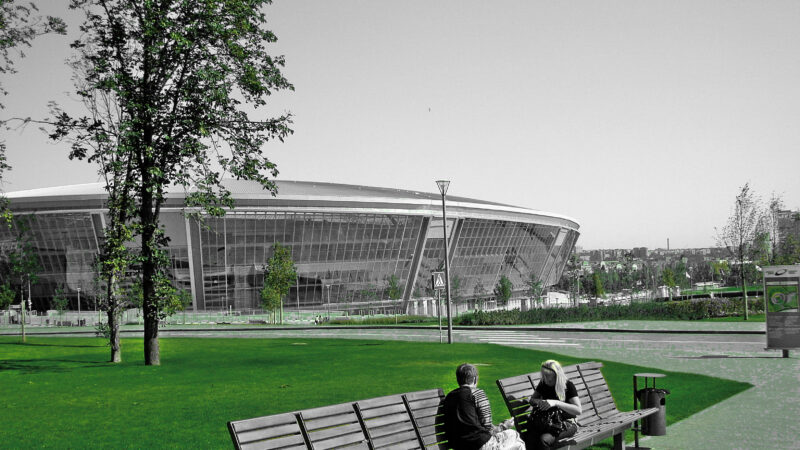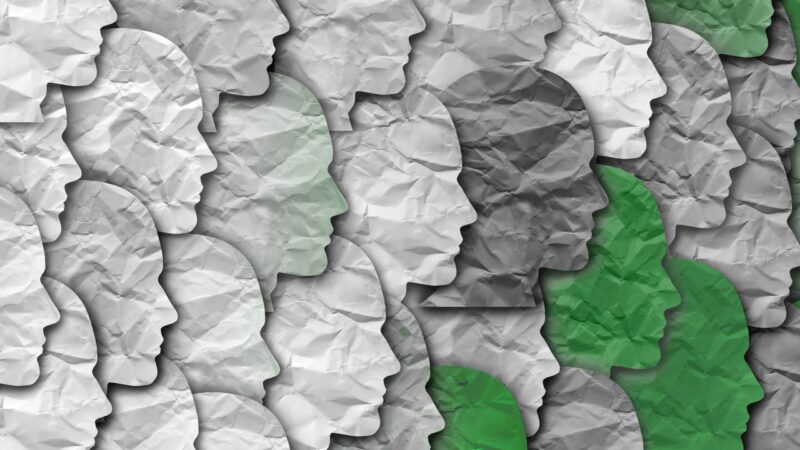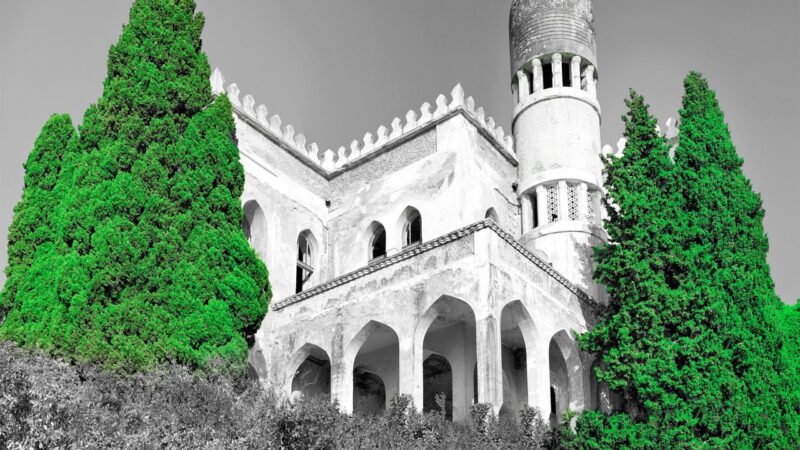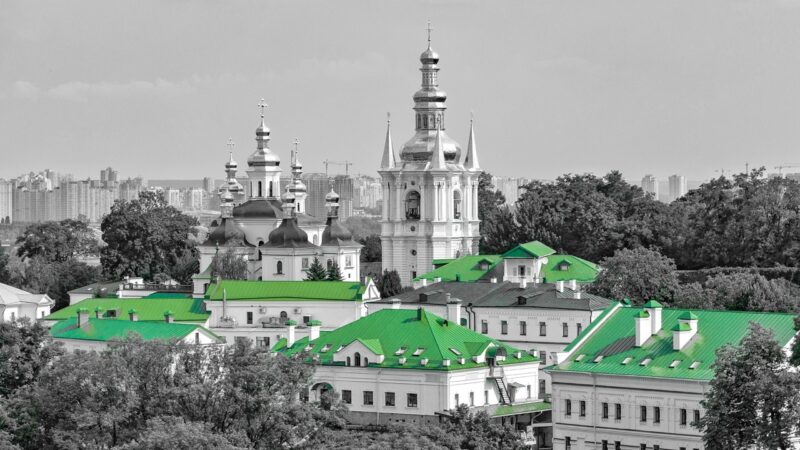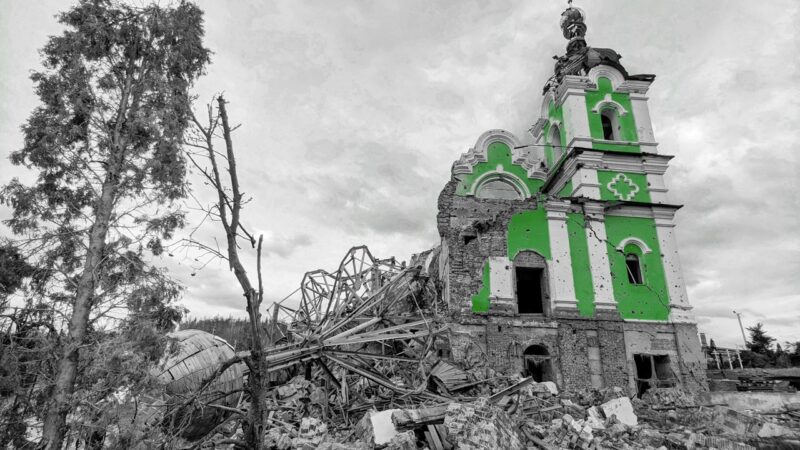What About the Drone? Ukraine Hosts Most Successful LGBTQ Event in the Nation’s History, but Not Without New Challenges
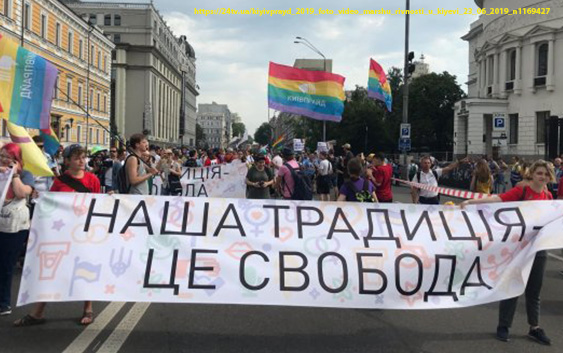
Ukraine recently hosted the largest and most successful Pride March in the 27-year history of the nation. Participants numbered around 8,000, a nearly tenfold increase over the first gathering in 2013 and subsequent years, when the police security presence often outnumbered that of participants. This year’s event was held on 23 June in downtown Kyiv, and was billed as part of the public activities taking place around the world by marchers calling for gender equality, same-sex marriage and reproductive rights, the reduction of sexual violence, and a range of related issues impacting Lesbian, Gay, Bisexual, Transgender, and Queer (LGBTQ) communities. This year, for the first time, Ukrainian military service people, veterans, and government employees from the Ministry of Health also joined Ukraine’s march.
Over the past four years, Kyiv Pride has increasingly received official support from the Ukrainian government throughout the planning process—in no small part due to the advocacy, combined with logistical support and safety advisories, of Embassies and other leaders in Ukraine that have shared expertise, training, and best practices from other pride marches around the world. One of the earliest advocates who initiated this solidarity is Rebecca Harms, former member of the European Parliament, for whom this year was her sixth time attending Kyiv Pride. Many other international supporters could also be seen at the march, with flags from different nations; NGOs, activists, and also local celebrities could be heard shouting, alternately in Ukrainian and English: Свобода! Рівність! Глобальнa солідарність! “Freedom! Equality! Global Solidarity!”
Roman Waschuk, Canada’s Ambassador to Ukraine, remarked to the press: “We’re here because Canada is an equality-seeking and promoting country. It’s taken our own country a while to move in the right direction, to make sure everyone has equal rights. And we want to share that experience with others” (Kyiv Post, 23 June 2019).
The level of professionalism among the organizers ensured the march was smoothly orchestrated. I had registered online in advance with the Kyiv Pride non-profit event organizer (Director Ruslana Panukhnyk). The instructions on when and where to meet were clearly communicated, and all information provided to registrants in the interest of safety was well prepared. Registrants received an email one day ahead of the march with instructions to gather on 23 June 2019 at 10 a.m. at the Kyiv Opera. The details included codes of conduct to guide marchers’ behavior, in the interest of promoting non-violent outcomes, such as: “Do not take pictures or try to communicate with the opposition.” There was also a short summary of the strict protocol on how to exit the march in order to ensure the safe disbursement of all the participants. There was also a map of the route: two blocks around the center, ending at 11 a.m. at the Teatralna Metro Station. A friend of mine, Olha, a long-time organizer of the march, let me know that these details had all been tested and refined over the years in the vital technical aspects of the planning process. There was also a great amount of effort invested toward maximizing police coordination for the march on behalf of city authorities and embassy advocates. In the inital years of the march, the exit strategies were disorganized or non-existent, leaving marchers in dangerously vulnerable situations, prone to attacks and physical violence that could have been avoided. Since then, things have come a very long way.
But success is never gained without challenges.
It was reported after this year’s march that Ukrainian state police had detained several people beforehand who had been planning, or had carried out, provocations against the demonstrations. There were no detainees during the march, although organizers did have to change the route slightly after a small but visible group of opponents gathered in Taras Shevchenko Park, along the planned route. These were mostly far-right and religious groups calling for “traditional values,” and yelling homophobic slurs while holding up signs with derogatory slogans. It was reported later that one marcher, 24-year-old Serhii Morozov, an activist who had traveled to Kyiv from Mariupol, was knocked to the ground at a metro station after being gassed, sustaining minor injuries. This is in contrast to the total of fifty-seven people detained and five people injured last year (Hromadske 17 June 2018).
Despite these incidents, there were far fewer counterdemonstrators this year, and they were less aggressive than what I had observed at the 2018 march. It was reported by Police Chief Serhiy Knyazev that fewer officers were needed. Yet the 12-foot-tall chain-link fences, shields, attack dogs, and billy clubs in the hands of the fully uniformed national police corps were still necessary—even if no longer nine rows deep, and without the storm of two hundred or so angry and shouting counterdemonstrators ready to charge at those standing on the LGBTQ side. Last year, I had arrived at the start of the march with an American friend of mine who was wearing rainbows, and at one moment a police officer shouted in his face, “Go home!” This obviously crossed beyond the bounds of keeping the peace, confirming what I had already known from many years of research conducted among gender rights and feminist activists in Ukraine: nothing can be taken at face value, and things are never as they seem on the surface.
As I crossed the barricades into the march this year, I could see a large drone hovering above the crowds, over the dividing fence between marchers and counterdemonstrators. A rainbow flag tied to its antennae fluttered like a kite in the wind. But my immediate reflex was not celebratory. I did not wave and smile at this flying machine, as I saw so many others around me doing. Instead, I turned away and hid my face from its lenses, pivoting my sightline to look in the direction of the column of marchers, and as I did so, I thought about the thousands of streams of digital information being captured, broadcast, and geo-tagged in the approximately one-mile radius surrounding the Opera House.
This drone was just one of the streams—but the most visible mark—of the virtual panopticon that I was standing in: a net of invisible information so thick with devices, IPs, and bots that it was hardly surprising the streets appeared “calmer” than they did last year. The presence of the drone flying the rainbow flag over the space where there had previously stood an angry mob did not, in my view, stand for progress. The drone did not signify the absence of the mob, but was a warning sign—a call to remain vigilant about the fact that political winds on human rights issues tend to shift very quickly. This is because in the global network—increasingly informed, and also disinformed, through the deployment of symbols—everyone on either side of the fence is potentially at the mercy of the drone.
On 18 June 2019, just a few days before the march, far-right groups announced online that they would hold a counterdemonstration in front of Ukraine’s presidential administration building. In 2017 the U.S. Embassy in Kyiv had issued a joint statement—signed by ambassadors to Ukraine from Canada, the E.U. Delegation, and several other nations—standing against the positions expressed by such groups (Joint Statement 17 May 2017).
This year the Bellingcat Monitoring Project[1] on Twitter issued details about the counterdemonstrators’ announcement, which was posted by a newly formed Ukrainian far-right extremist anti-LGBTQ online umbrella group “Tradition and Order” (Традиція і порядок), using the slogan “Nation, Faith, Family” (Держава, віра, сім’я). According to Bellingcat, the group includes members from other far-right entities (Katekhon, Bratstvo, and C14); it had formed in the Telegram online platform under the channel “Oppose LGBT” (Протидія ЛГБТ). Among their goals: “to prevent further provocations on the part of the LGBT that are aimed at deepening conflicts in society” (Korrespondent June 16 2019). Eduard Yurchenko, an ideologue of Azov and founder of a new anti-LGBT group, Orden, planned to join the counterdemonstration, along with Yuri Noievoi, a people’s deputy in the Kyiv Oblast Administration from the “Svoboda” military organization and a vocal leader in actions against LGBTQ and feminist movements via the group Katekhkon.
In addition to promoting anti-LGBT actions ahead of Kyiv Pride, it was reported that out of the estimated 463 group members, many had adopted neo-Nazi usernames or positions (UkrPravda 16 June 2019). A known far-right member was Serhii Mazur of C14, which last year issued calls on Facebook promoting attacks on a Roma camp in Kyiv. Information from these groups also circulates in other far-right Telegram channels, including avtonom.ns, a channel that uses violent rhetoric and names its targets as Roma, LGBT, feminists, and racial minorities.
What this online activity reveals is a critical need for more leaders and experts on Ukraine to name directly the problem of extremist civilian groups who organize and call for violence. Inside the march itself, everything this year appeared under control—yet online forces aimed to target and erase LGBT and other voices from the public square. The success of the march gave the appearance of being able to stand in a free association of political symbols clashing with one another—there was even a demonstrator inside the barricades with an anti-LGBT flag, and this was respected on both sides as an individual right to self-expression.
Yet these divisions in opinion, viewed by a drone from above, could then potentially circulate online in channels that exploit opinion and use symbolic violence: to disrupt the freedom of peaceful assembly, to call for harm to specific people or social groups, and to block the peaceful exchange of opposing views.
As many in post-Soviet contexts know, cultivating a culture of debate and airing controversy prevents the silent majorities from forming political monopolies or repressing the expression of individuality for the sake of building and manipulating group identities. George Orwell’s concept of groupthink in the dystopian novel 1984 was bound up in a language that he named double-speak, a grammatical negation built into the utterance of a statement, as if jamming the message into a feedback loop of silence. These are the dynamics of self-censorship, which marginalized communities are especially adept at circumventing in communities of care and empowerment.
The official slogan for this year’s KyivPride was “Freedom, Unity, Struggle!” (Свобода, єдиність, боротба). In Ukraine today, a nation at war, the word “struggle” carries heightened significance. The participation this year of military veterans in the march, and the global stakes of the Ukraine-Russia conflict, illuminate this slogan as a war within a nation at war: the war to be oneself before a tolerant public. This is a war fought on a battlefront internal to the self, between and within families, lovers, and others in cities, towns, and villages everywhere. Not taking into account variance across ancient and modern societies, in our century the fight to live free in one’s gender and sexuality has left millions displaced, imprisoned, and disappeared. There can be no more closing our eyes to this fact in an increasingly interconnected world.
Many in Ukraine today ask why there is not more of an outpouring of support from Western institutions against the extremist groups endangering society. Human Rights Watch reported on hate crimes in Ukraine in 2018, noting the failure of police and officials to respond. Amnesty International included severe attacks at an LGBTQ event in the city of Zaporizhia in its Ukraine 2017/2018 report, as well as the attack and killing of Roma in 2018 and the failure of Parliament to ratify the Council of Europe Convention on preventing and combating violence against women and domestic violence (Istanbul Convention), signed in 2011.
The manipulation of positions by different interest groups against LGBTQ rights who attach their claims in this field of action is of concern for any democracy. Scholars across the disciplines have developed a diverse set of perspectives on the subject since the rise of pride marches in the mid-2010s. Anthropologist Jasbir Puar is credited for one of the most groundbreaking inquiries into the idea of “homonationalism” in her analyses of U.S. legislation around same-sex marriage. Others have continued to explore the implications of state and private entities’ different forms of political investments in Pride and other pro-LGBTQ activities as having many unpredictable outcomes for communities seeking greater visibility and gender justice.
The right to publicly organize and demonstrate peacefully is a sacred right, and a critical part of what is most human in all of us. Disagreement can be generative, but the far-right groups calling for violence against specific targets in Ukraine’s population—not only LGBT but many others as well—should not only be condemned but actively named for who they are: extremists that terrorize people. This is not a new problem, and not unique to Ukraine, as officials in Germany and Poland especially have had to struggle in recent years to keep such groups at bay, opening dialogue about the legacy of the Holocaust, along with the enforcement of policies against hate crimes. One of the key gains of the Maidan Revolution of Dignity in 2013–14 included the signing of an Anti-Discrimination Law in 2015. But Ukraine today seems to have reverted to silence about neo-Nazism.
Global NGOs, Embassies, and scholars working in Western institutions have a responsibility to bring more awareness to the issues undermining the successes of the LGBT march by directly naming and studying the problem of Ukraine’s organized far-right groups. The only ethical response available is to move the issue of extremism onto the table, with the hope that best practices and policies can be adopted and that mutual tolerance will prevail. The stakes are global.
Jessica Zychowicz
CUSP-CIUS
University of Alberta
11 July
2019
[1] Bellingcat Monitoring Project is a new initiative involving several journalists from the Bellingcat organization, an internationally recognized media watchdog. Two journalists on the initiative are Alexei Kuzmenko, who specializes on Ukraine, and Michael Kolborn, who attended last year’s Kyiv Pride march.

